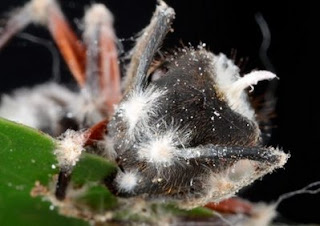Oddly, there's nothing very zombie-like about the actual ants. It's only when a particular fungus takes over the ant's brain that things get weird.
Once the "stalk of the newfound fungus species Ophiocordyceps camponoti-balzani infects an ant, the ant gives up control over its own body. After the fungus is in control, it forces the ant to scamper toward "a location ideal for the fungi to grow and spread their spores." Then, it's lights out for the ant. Who knew a fungus could be so diabolical.
Lodged in a zombie ant's brain, the fungi species 'direct' the dying ants to anchor themselves to leaves or other stable places, as pictured above—providing a stable 'nursery' for the fungus. For instance, as the Ophiocordyceps camponoti-balzani fungus is about to kill the ant, the insect bites down hard into whatever substance it's standing on. This attachment is so strong that a dead zombie ant can remain stationary even when hanging upside down, the scientists say.
White fungus stalk begins to poke
A white fungus stalk (left) of the Ophiocordyceps camponoti-rufipedis species begins to poke through the head of a zombie ant two days after death. Also noticeable are faint, white, slightly fuzzy fungal growths on the ant's joints. Once the insect dies, the fungus rapidly spreads through the body. During the first couple days, though, very little evidence of the fungus is visible from the outside.
Later stages of Ophiocordyceps camponoti-rufipedis ...
During later stages of Ophiocordyceps camponoti-rufipedis infection, the fungus rapidly consumes the nutrients inside a zombie ant and begins to colonize the outside of the ant's body, as pictured. The fungus stalk growing from the back of the head (upper right) also becomes longer and more noticeable.Mature fungus stalk, shown, differs
Final stalk: The mature fungus stalk, shown growing from a zombie ant's head during the final stage of infection, differs among fungi species.
These wild discoveries were made by a group in Brazil headed by entomologist David Hughes. National Geographic published a series of pictures of ants that have "lost their minds" to the fungus. You can check out a sample of them below. Not for the squeamish.




No comments:
Post a Comment